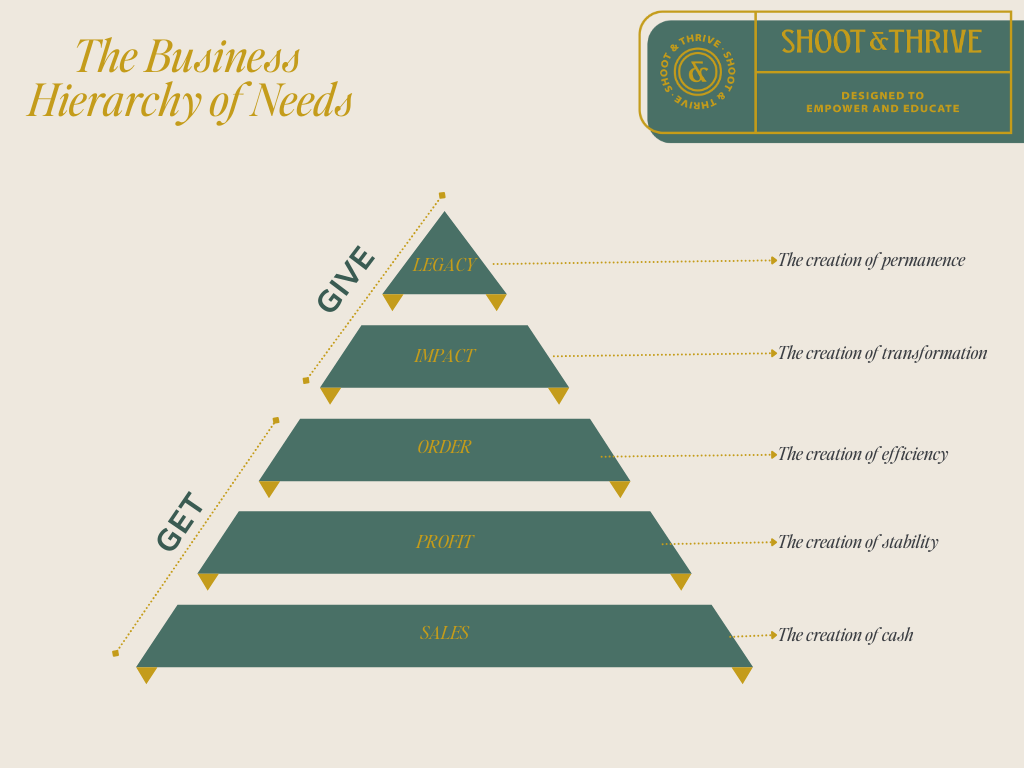We're a team of wedding, elopement and portrait photographers who put community over competition. We provide tips and resources for Photographers looking to up-level their businesses.
We're here to help When you join The Photography Business Academy
Mastering the Business Hierarchy of Needs: A Guide for Photographers
As photographers, we often start our businesses with the dream of creating a life we love—doing what we’re passionate about while having the freedom to manage our own schedules.
But what does it truly mean for your photography business to serve you?
More importantly, how can you structure your business so that it not only meets your financial needs but also creates a life of freedom and fulfillment?
Throughout this post, we’ll look to answer some of these questions as we explore the business hierarchy of needs.
To go even deeper, sign up for our FREE mini-course Business Fundamentals for Photographers where we talk even more about this topic and others that can help you ground your thinking so you can make more intentional changes to things like your brand, website, marketing, sales, and systematization of your business.
The Reality of Running a Photography Business
Like we just said, many of us start our photography businesses for the love of the craft. After all, it’s exciting to think that you can make a living doing something you enjoy like photography.
But, as time goes on, reality often sets in.
Long hours of editing, chaotic schedules, and unpredictable client demands can leave you feeling burnt out.
You may find yourself questioning if this “dream” career is really giving you the freedom you were hoping for…
While the flexibility to set your own hours is appealing, the constant grind can start to take its toll.
Does any of this sound familiar?
If so…you’re not alone!
Many photographers end up in this cycle, where the dream of freedom feels just out of reach.
So, how do you break free?
The answer is multi-faceted, but begins by understanding the business hierarchy of needs! Let’s talk about it!
The Business Hierarchy of Needs for Photographers

To understand how to get your photography business to truly serve you, it’s helpful to consider the Business Hierarchy of Needs, a concept developed by Mike Michalowicz in his book Clockwork.
This hierarchy is based on the psychologist Abraham Maslow’s famous pyramid of needs, which outlines human needs from basic survival (food, water, shelter) to self-actualization (personal fulfillment and purpose). Similarly, your business must fulfill foundational needs before it can reach its full potential.
Here’s how Michalowicz adapts the hierarchy for business:
- Sales (Survival)
- Profit (Sustainability)
- Order (Efficiency)
- Impact (Transformation)
- Legacy (Permanence)
Let’s dive deeper into each tier and what they mean for your photography business!
1. Sales: The Lifeblood of Your Business
At the foundation of the business pyramid is sales—your business needs money to survive.
We all know this, right?
If your photography business isn’t generating income, it won’t last.
Early on, many photographers focus heavily on booking clients and securing sales, which is necessary to keep the doors open.
However, focusing solely on sales without moving up the pyramid will leave you stuck in survival mode.
You might find yourself constantly chasing bookings without ever feeling like you’re gaining any real momentum…
If this sounds like you, The Photography Business Academy has many courses that can help you get your photography business on track and profitable!
2. Profit: Keeping More of What You Make
The next tier is profit.
It’s not enough to just make money—you need to keep more of it.
Many photographers get stuck in a cycle of making money and spending it just as quickly. If your business expenses are higher than your income, you’re still at risk of burnout and failure.
At this stage, it’s important to create a business model that allows for healthy profit margins. This might mean raising your prices, cutting unnecessary expenses (budgeting can help with this!), or finding ways to reduce your workload without sacrificing income.
3. Order: Creating Efficiency
Once you’ve established steady sales and profit, the next step is creating order in your business.
This means developing efficient systems that allow your business to run smoothly without requiring your constant attention.
For photographers, this could mean outsourcing time-consuming tasks like editing, album design, or even client communication. By creating more order, you free up your time to focus on high-value tasks—or take time off to recharge.
For example, in my own photography business, I used profits to outsource culling, editing, and album design. This allowed me to work fewer hours while still maintaining the quality my clients expected. I went from feeling overworked to having the freedom to choose how I spend my time.
4. Impact: Making a Difference
With efficiency in place, your business will begin to serve you—and others—in a more meaningful way.
The next tier, impact, is about creating a positive transformation for your clients and your community.
As a photographer, this might mean focusing on the client experience, ensuring that you’re not just delivering beautiful photos but providing a memorable, transformative experience.
It could also mean using your photography skills for a cause you care about, such as donating sessions to local charities or giving back in other ways. A great example of an organization you can volunteer in this way is Now I Lay Me Down to Sleep, which portrait photographers can offer complimentary portraits to parents’ experiencing stillbirth.
5. Legacy: Building Something That Lasts
The top of the pyramid is legacy—creating something that lasts beyond you.
At this stage, your business is no longer just about survival or profit, but about creating a lasting impact. You’ve built a business that can thrive without your constant involvement, and you have the freedom to focus on bigger-picture goals.
For us, this is where our work on Shoot and Thrive comes in. We wanted to create a business that not only supports our lives but also helps other photographers create the life they want. We were only able to dedicate the time, money and other resources to bringing this to life due to the successes we had already achieved in our other business ventures.
Did you know? It took us close to 3 years to bring The Photography Business Academy to life because of our commitment to creating a high value educational course that would be transformative for the students who take it.
With a solid foundation of sales, profit, and order in place, we’ve been able to focus on making a difference and leaving a legacy in the photography community.
How to Apply the Business Hierarchy of Needs to Your Life and Business
The business hierarchy of needs isn’t just a theoretical concept—it’s a practical roadmap for structuring your photography business. Here’s how you can start applying it today:
- Assess your current stage: Are you focused on survival (sales), or have you moved up the pyramid to create profit and efficiency?
- Create a plan for moving up: If you’re stuck in survival mode, focus on creating steady income and building profit. Once you have that in place, start implementing systems to streamline your workload and create more order.
- Focus on impact and legacy: Once your business is running efficiently, think about how you can use your time and resources to make a difference in the lives of your clients and your community.
Final Thoughts
The ultimate goal of any photography business should be to serve you—not the other way around.
By understanding and applying the Business Hierarchy of Needs, you can build a business that not only meets your financial goals, but also gives you the freedom and fulfillment you’ve been striving for.
Take the time to reflect on where you are in this pyramid and create a plan to move forward. Whether it’s increasing your profit margins, outsourcing tasks, or focusing on creating a lasting impact, each step will bring you closer to a business that supports the life you want to live.
To go even deeper, sign up for our FREE mini-course Business Fundamentals for Photographers where we talk even more about this topic and others that can help you ground your thinking so you can make more intentional changes to things like your brand, website, marketing, sales, and systematization of your business.

Honesty is a cornerstone of Shoot and Thrive, so we want you to know that some links in this post are affiliate links. This means we may earn a commission if you make a purchase—at no additional cost to you. We only recommend products and services we trust, have used ourselves, or have thoroughly researched based on industry feedback. Our goal is to provide solutions that genuinely help, whether they come from our direct experience or the collective knowledge of the photography community.
As photography business educators, we believe it's important for educators in this industry to be active photographers themselves. The images used throughout this website were taken through our photo studios - Hand and Arrow Photography and Marshall Scott Photography, except for stock images or if otherwise noted.
Turn Your Passion into a Thriving Business
Transform your photography business into a streamlined, profitable venture that gives you more time, freedom, and confidence.
With the Photography Business Academy, you’ll have a step-by-step guide to building the business—and life—you’ve always dreamed of. From branding to marketing, finances to client experience, we’ve got you covered.
Navigation
Shoot and Thrive is an ethically created resource for photographers needing mentorship, coaching, or business education. We believe in creating content that’s easy to digest and retain while incorporating educational best practices, so you gain clarity and confidence as a business owner.